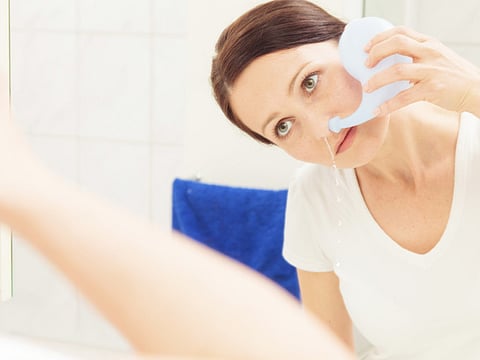Yoga for sinusitis relief
Learn how to use a neti pot in two easy steps

Sinusitis is an inflammation of the tissue lining the sinuses. Sinuses are hollow air spaces within the bones surrounding the nose. When sinuses become blocked and filled with fluid, germs can grow and cause an infection. There are different types of sinusitis such as acute, subacute, chronic and recurring.
Following is a yogic technique for purification of the nasal tract that is of tremendous help for those suffering from sinusitis and is also recommended by the medical fraternity.
Jala Neti (nasal cleansing with water).
A special ‘neti pot’ or nasal cleansing pot should be used, which is easily available in pharmacies. The water should be at body temperature and thoroughly mixed with salt in the proportion of one teaspoonful per half litre of water. The addition of salt ensures the osmotic pressure of the water is equal to that of the body fluids, thereby minimising any irritation to the mucus membrane. If a painful or burning sensation is felt, it is an indication that there is either too little or too much salt in the water.
Stage 1: Washing the nostrils
Fill the neti pot with the prepared salt water. Stand squarely, legs apart and lean forward. Close the eyes for a minute or so and relax the whole body. Tilt the head to one side and slightly back. Begin to breathe through the mouth. Gently insert the nozzle into the uppermost part of the nostril. The nozzle should press firmly against the side of the nostril so that no water leakage occurs.
Tilt the neti pot in such a way that water runs into the nostril and not down the face. Adjust the body position to enable the water to pass out through the other nostril. When half the water has passed through the nostrils, remove the nozzle from the nostril, centre the head and let the water run out of the nose. Remove any mucus from the nose by blowing gently. Tilt the head to the opposite side and repeat the process, placing the nozzle of the pot in the other nostril. After completing this process the nostrils must be thoroughly dried.
Stage 2: Drying the nostrils
Stand erect. Close the right nostril with the right thumb and breathe in and out through the left nostril 10-15 times in quick succession, emphasising exhalation as in kapalbhati (frontal lobe cleansing) pranayama. Repeat through the right nostril, with the left nostril closed. Perform once more through both nostrils.
Bend forward from the waist so that the trunk is horizontal. Repeat the same process but tilt the head to the right, closing the left nostril. Repeat again, tilting the head to the left and closing the right nostril. Finally, repeat again with the head centred, breathing through both nostrils.
Benefits
Jala neti removes mucus and pollution from the nasal passages and sinuses, allowing air to flow without obstruction. It helps prevent and manage respiratory tract diseases.
It helps to relieve allergies, colds and sinusitis, together with various disorders of the ears, eyes and throat.
Jala neti relieves muscular tension of the face, nervous tics, and helps the practitioner maintain a fresh and youthful appearance.
Jala neti stimulates the various nerve endings in the nose, improving the activities of the brain and the overall health of the individual.
NOTE:
This practice should take about five minutes. It may be practised once daily first thing in the morning. However, if necessary, it may be performed at any time except just after meals.
The water should only pass through the nose. If any water enters the throat or mouth it is an indication that the position of the head needs to be adjusted. It is essential that the nose is properly dried after the practice. Do not blow the nose too hard. If force is used, the remaining water may be pushed into the ears.
Those people who suffer from chronic bleeding in the nose or have great difficulty passing water through the nose may have a structural blockage and should seek expert advice.
It is advisable to learn this technique with a yoga professional before commencing on your own.
Next week: Yoga for relief from migraine.
Sign up for the Daily Briefing
Get the latest news and updates straight to your inbox



